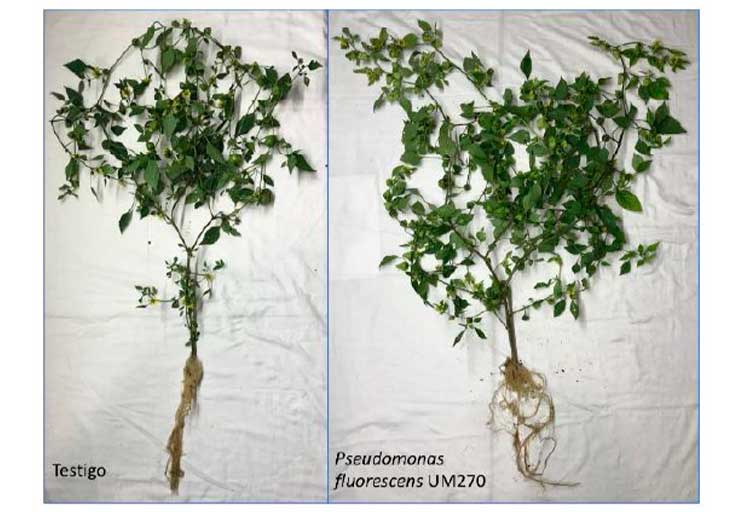Pseudomonas fluorescens UM270 promotes growth and production in husk tomato
DOI:
https://doi.org/10.29312/remexca.v14i4.3017Keywords:
Physalis ixocarpa, Pseudomonas fluorescens, agrochemicals, rhizobacteriaAbstract
One of the agroecological strategies that increases agricultural production is the use of bacterial inoculants, which lack the toxic effects that agrochemicals have. This work evaluated the effect of inoculation of the plant growth-promoting rhizobacterium Pseudomonas fluorescens UM270 on the cultivation cycle of husk tomato (Physalis ixocarpa) plants under field conditions (irrigation) in 2019. The results showed that plants inoculated with the rhizobacterium UM270 exhibited significant effects on plant height (14.64%), stem diameter (17.74%), biovolume index (35.14%) and fruit set production by 65.54%. This suggests that the strain UM270 of P. fluorescens is an excellent bioinoculant that improves the production of the husk tomato crop under field conditions.
Downloads
References
Aguirre-Medina, J. F. y Espinosa, M. J. A. 2016. Crecimiento y rendimiento de Capsicum annuum L. inoculado con endomicorriza y rizobacterias. Rev. Mex. Cienc. Agríc. 7(7):1539-1550. Doi: https://doi.org/10.29312/remexca.v7i7.148. DOI: https://doi.org/10.29312/remexca.v7i7.148
Ayala-Armenta, Q. A.; Tovar-Pedraza, J. M.; Apodaca-Sánchez, M. A.; Correia, K. C.; Sauceda-Acosta, C. P.; Camacho-Tapia, M. and Beltrán-Peña, H. 2020. Phylogeny and pathogenicity of soilborne fungi associated with wilt disease complex of tomatillo (Physalis ixocarpa) in northern Sinaloa, Mexico. Eur. J. Plant Pathol. 157(4):733-749. https://doi.org/10.1007/s10658-020-02030-9.
Caballero-Salinas, J. C.; Ovando-Salinas, S. G.; Núñez-Ramos, E. y Aguilar-Cruz, F. 2020. Sustratos alternativos para la producción de plántulas de tomate de cáscara (Physalis ixocarpa Brot.) en Chiapas. Siembra. 7(2):14-21. https://doi.org/10.29166/siembra. v7i2.1916.
Castro-Barquero, L.; Murillo-Roos, M.; Lorío, L. U. y Mata-Chinchilla, R. 2015. Inoculación al suelo con Pseudomonas fluorescens, Azospirillum oryzae, Bacillus subtilis y microorganismos de montaña (mm) y su efecto sobre un sistema de rotación soya-tomate bajo condiciones de invernadero. Agron. Costarricense. 39(1):21-36. https://revistas.ucr. ac.cr/index.php/agrocost/article/view/21787/21990.
Engels, J. M. M.; Ebert, A. W.; Thormann, I. and De Vicente, M. C. 2006. Centers of crop diversity and/or origin, genetically modified crops and implications for plant genetic resources conservation. Genetic Res. Crop Evol. 53(8):1675-1688. https://doi.org/10.1007/s10722-005-1215-y. DOI: https://doi.org/10.1007/s10722-005-1215-y
Flores, A.; Diaz, Z. J. T.; Orozco, M. M del C.; Chávez, A.; Santos, V. S.; Valencia, C. E. and Santoyo, G. 2020. Bridging genomics and field research: draft genome sequence of Bacillus thuringiensis CR71, an endophytic bacterium that promotes plant growth and fruit yield in Cucumis sativus L. 3 Biotech. 10(220):1-7. https://doi.org/10.1007/s13205-020-02209-1.
Garrido-Sanz, D.; Meier-Kolthoff, J. P.; Göker, M.; Martín, M.; Rivilla, R. and Redondo-Nieto, M. 2016. Genomic and genetic diversity within the Pseudomonas fluoresces complex. PLoS ONE. 11(2):1-30. https://doi.org/10.1371/journal.pone.0150183. DOI: https://doi.org/10.1371/journal.pone.0150183
Hernández-León, R.; Rojas-Solís, D.; Contreras-Pérez, M.; Orozco-Mosqueda, M. D. C.; Macías-Rodríguez, L. I.; Reyes-Cruz, H.; Valencia-Cantero, E. and Santoyo, G. 2015. Characterization of the antifungal and plant growth-promoting effects of diffusible and volatile organic compounds produced by Pseudomonas fluorescens strains. Biol. Control. 81(2):83-92. https://doi.org/10.1016/j.biocontrol.2014.11.011. DOI: https://doi.org/10.1016/j.biocontrol.2014.11.011
Orozco-Mosqueda, M. del C. and Santoyo, G. 2021. Plant-microbial endophytes interactions: Scrutinizing their beneficial mechanisms from genomic explorations. Current Plant Biol. 25(1):100189. https://doi.org/10.1016/j.cpb.2020.100189.
Orozco-Mosqueda, M.; Santoyo, G. and Glick, B. R. 2023. Recent advances in the bacterial phytohormone modulation of plant growth. Plants. 12(3):606. https://doi.org/10.3390/ plants12030606.
Patel, P.; Shah, R.; Joshi, B.; Ramar, K. and Natarajan, A. 2019. Molecular identification and biocontrol activity of sugarcane rhizosphere bacteria against red rot pathogen Colletotrichum falcatum. Biotechnology Reports. 21(1):1-8. https://doi.org/ 10.1016/j. btre.2019.e00317.
Ramírez-Cariño, H. F.; Morales, I.; Guadarrama-Mendoza, P. C.; González-Terreros, E.; Martínez-Gutiérrez, G. A.; Dunlap, C. A. and Valadez-Blanco, R. 2023. Biofertilizing effect of putative plant growth promoting rhizobacteria in vitro and in tomatillo seedlings (Physalis ixocarpa Brot.). Sci. Hortic. 308(2):111567. https://doi.org/10.1016/j.scienta.2022. 111567.
Rocha-Granados, M. A. D. C.; Cubillo-Constantino, M. A.; Delgado-Valerio, P.; García-Magaña, J. y Santoyo, G. 2019. Aumento de tolerancia de Casuarina equisetifolia a cloruro de sodio mediado por Pseudomonas fluorescens. Biotecnología en el Sector Agropecuario y Agroindustrial. 17(2):15-23. Doi: http://dx.doi.org/10.18684/bsaa.v17n2.1249.
Rojas-Solis, D.; Hernandez-Pacheco, C. E. and Santoyo, G. 2016. Evaluation of Bacillus and Pseudomonas to colonize the rhizosphere and their effect on growth promotion in tomato (Physalis ixocarpa Brot. ex Horm.). Rev. Chapingo Ser. Hortic. 22(1):45-57. https://doi.org/10.5154/r.rchsh.2015.06.009. DOI: https://doi.org/10.5154/r.rchsh.2015.06.009
Santiaguillo-Hernández, J. F. y Blas-Yáñez, S. 2009. Aprovechamiento tradicional de las especies de Physalis en México. Rev. Geogr. Agríc. 43(2):81-86. http://hdl.handle.net/20.500. 11799/39862.

Published
How to Cite
Issue
Section
License
Copyright (c) 2023 Revista Mexicana de Ciencias Agrícolas

This work is licensed under a Creative Commons Attribution-NonCommercial 4.0 International License.
The authors who publish in Revista Mexicana de Ciencias Agrícolas accept the following conditions:
In accordance with copyright laws, Revista Mexicana de Ciencias Agrícolas recognizes and respects the authors’ moral right and ownership of property rights which will be transferred to the journal for dissemination in open access. Invariably, all the authors have to sign a letter of transfer of property rights and of originality of the article to Instituto Nacional de Investigaciones Forestales, Agrícolas y Pecuarias (INIFAP) [National Institute of Forestry, Agricultural and Livestock Research]. The author(s) must pay a fee for the reception of articles before proceeding to editorial review.
All the texts published by Revista Mexicana de Ciencias Agrícolas —with no exception— are distributed under a Creative Commons License Attribution-NonCommercial 4.0 International (CC BY-NC 4.0), which allows third parties to use the publication as long as the work’s authorship and its first publication in this journal are mentioned.
The author(s) can enter into independent and additional contractual agreements for the nonexclusive distribution of the version of the article published in Revista Mexicana de Ciencias Agrícolas (for example include it into an institutional repository or publish it in a book) as long as it is clearly and explicitly indicated that the work was published for the first time in Revista Mexicana de Ciencias Agrícolas.
For all the above, the authors shall send the Letter-transfer of Property Rights for the first publication duly filled in and signed by the author(s). This form must be sent as a PDF file to: revista_atm@yahoo.com.mx; cienciasagricola@inifap.gob.mx; remexca2017@gmail.
This work is licensed under a Creative Commons Attribution-Noncommercial 4.0 International license.


